Tu-16: aircraft era. Part II. From birth to the series
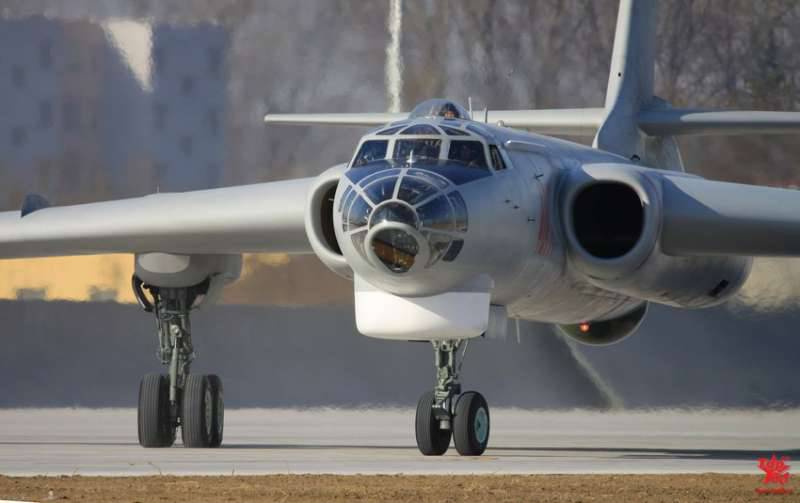 [/ Center]
[/ Center]In the Tupolev design bureau, during the preliminary design of the 88 project (this internal designation was received by the future famous Tu-16), dozens of variants of various layouts were worked out. As a result, we chose a variant with two turbofan engines by A. Lyulki AL-5, located in nacelles pressed to the sides of the fuselage, for further development.
The search for the Tupolev design bureau of the optimal variant of the new jet machine with tactical and technical characteristics exceeding those stated in the IL-46 project was quite positively received by the Air Force Command and the government of the country. The OKB issued an official task to develop a new OKB AN bomber. Tupolev. In the summer of 1950, the relevant Resolution of the USSR Council of Ministers and the MAP order were issued, on the basis of which Tupolev was assigned to create a long-range jet bomber equipped with two TRDs of the TR-ZF type (previously called TR-ZA) in the AL-5 series, having take-off thrust in 5000 kg. In these documents was also provided for the development of the aircraft under the two engines A. Mikulin AMRD-03 with a maximum thrust to 8000 kg.
The difficult task of determining the dimension of the machine and the subsequent aerodynamic as well as constructive layout was finally solved as a result of the large number of parametric studies conducted, extensive model experiments and field tests. In the course of these works, it quickly became clear that the total thrust of the two ALD-5 TRDs to ensure the specified characteristics was clearly insufficient, and the designers decided to switch to the two AMRD-03 TRDs (in the series received the name AM-3); four engines AL-5. In February 1951, A.N. Tupolev chose for further design on a version that has two AM-3 engines. But it is worth noting that the issue with the power plant for the Tu-16 was finally resolved several months later, after this powerful engine became a reality.
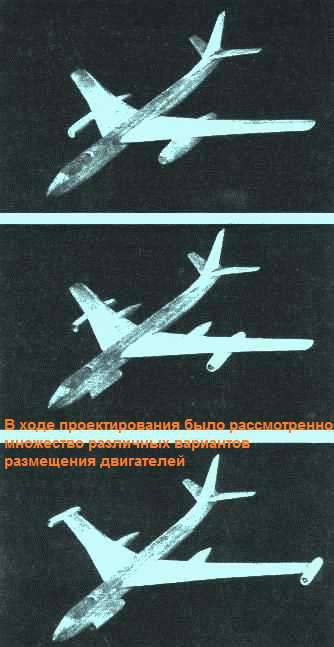
Active work on the 88 aircraft project began in mid-June 1950, and in September, after the transition to the power plant based on the AM-3 engines, the tactical and technical requirements for the new machine were supplemented by relevant instructions from the Air Force. The overall design was officially completed at the end of April 1951, when the prepared draft design was transferred to the Air Force Technical Committee. Draft design of a bomber with AM-03 jet engines. The customer finally approved 5 of July of the same year.
A great influence on the aerodynamic perfection of the airship was exerted by the unusual for those times layout of the central part of the machine, where the fuselage-wing-air intake-engine-chassis mated, which fully complied with the aerodynamic "area rule" actively started to be introduced into the aircraft-building world practice only from 1954 year, with the advent of an experienced fighter YF-102А, on which the Americans managed to make a steady supersonic flight. Only after changing the basic design with this rule. It was then that the Americans to the whole world declared themselves the pioneers of this law of aerodynamics, it happened three years after its use in the project of the 88 aircraft. It should be noted that the “space rule” in various forms was used in the design of Tupolev machines before, it is enough to pay attention to the somewhat inflated front part of the fuselage of the Tu-2 bomber, or the expanded nacelles of the first Tupolev jet machines - “77”, “73-81” . On the “88 plane”, the use of the “space rule” was manifested in the form of compression of the side gondolas of the turbojet engines in the wing area and in the use of chassis gondolas located on the wing in the form of “displacement bodies”. In combination with other aerodynamic techniques, this allowed, after the installation of the RD-3M turbofan engine, to obtain during testing the maximum speed equal to 1040 km / h (0,92М).
The technical features of the new Tupolev Design Bureau should also mention the design solutions for the wing. For the bomber, the designers chose a wing with a large extension (of the order of 7). By design, it was a two-spar scheme, while the walls of the side members, together with the outer (upper and lower) wing skin panels, formed a caisson, which is the main force element. The presence of a powerful hard caisson was the principal difference in the design of the Tu-16 bomber wing from the design of the well-known overseas jet bombers of the Boeing B-47 and B-52 company. On American machines, the wing was made flexible, due to which the counter-vertical vertical gusts were extinguished, due to a significant bend (the cantilever was deflected by several meters) and deformations of the wing. The scheme chosen by Soviet designers with a tougher wing of the Tu-16 aircraft proved to be better, being more promising than the American scheme widely advertised by Americans as an outstanding design solution. The wing of the Soviet aircraft in flight was not greatly deformed due to the reduced stress level. In the following years, the long-term operating experience of one and a half thousand Tu-16 and two hundred Tu-104 in the USSR and the experience of flying B-47, B-52 bombers in the USA, as well as Boeing 707, Douglas DS-8 and Convertible 880 passenger aircraft showed that The domestic design of the less flexible wing has a significantly greater survivability, especially in terms of fatigue strength. In the US, there were a lot of problems with the wing planes B-47 and B-52, on which fatigue cracks developed, which caused accidents and flight stoppages for the entire fleet with additional costs for reworking and reinforcing the wing structure. Now it is not a secret that the relatively rapid decommissioning of the B-47, which had generally good characteristics, was largely due to the “weak” wing.
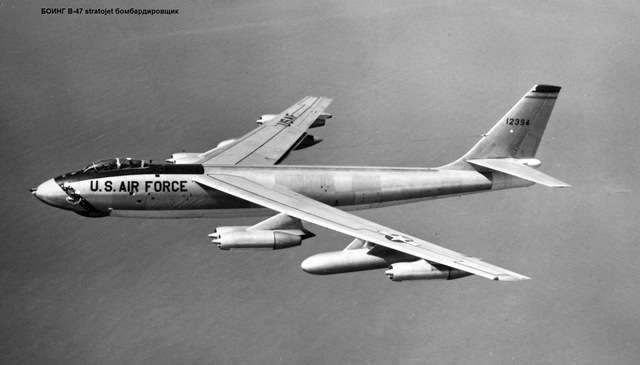
Considering that Tu-16 was considered as the first distant mass domestic carrier of atomic weapons (several dozen carriers of the first Soviet nuclear bombs Tu-4A, which were at one time in operation, could hardly be called a reliable atomic "shield of deterrence"), the designers of the OKB, TsAGI and other related organizations related to the atomic problem were assigned the task of ensuring the safety of the Tu-16 in explosions of nuclear and, subsequently, thermonuclear ammunition.
It should be noted that the design of the bomber, the choice of structural materials, target equipment and systems, as well as production technologies were selected and worked out on the basis of the real capabilities of the Soviet aviation industry of that time and the conditions for the possibility of rapid deployment of mass production and mass operation. This approach made it possible to create a modern aviation shock system, which became one of our main deterrents in the fifties.
All the work on the Tu-16, from the very first prototype machine to the most extreme production and development options, and their order was 50 (together with the experimental machines there were almost 100), the main designer was headed by D.S. Markov.
At the end of April 1952, an experienced 88 / 1 made a flight that lasted 12 minutes. Factory tests ended on October 29 1952 of the year; in total, 46 flights of the total duration of 72 hours 12 minutes of mines were made during them.
Along with encouraging indicators, it is impossible not to note the "fly in the ointment" in the form of unsatisfactory range indicators and take-off and landing data. According to these characteristics, the "eighty-eighth" did not reach the values specified in the TTZ, which was especially critical given the purpose of the aircraft. This trouble was discovered by the summer of 1952, after several weeks of factory testing. The reasons were not a secret - the machine was rather heavy in the course of design and manufacturing. As a result of the control weighing, it turned out that the weight of the empty aircraft reached 41050 kg versus the calculated 35750 kg, and this even without taking into account equipment and armament not mounted on an experimental machine. Take-off weight increased to 77350 kg, and in the original project it was planned no more than 64000 kg. Excess weight on 20% affected the flight data, threatening the natural dissatisfaction of the military customers and leadership of the country. According to the characteristics of the technical range, the aircraft did not reach 400 km to the target, and the flight altitude above the target instead of the agreed 13000 m did not exceed 12200 m. The length of the plane’s takeoff exceeded the one set by 520 m.
13 November 1952, the car was passed to state tests, which took place from mid-November 1952 year to 1 April 1953, for a relatively short period of time on an experienced "88 / 1" conducted 79 flights, total duration 167 h 28 minutes. Even during the factory tests, before obtaining the results of state tests, it was decided to master the "88 aircraft" in mass production.
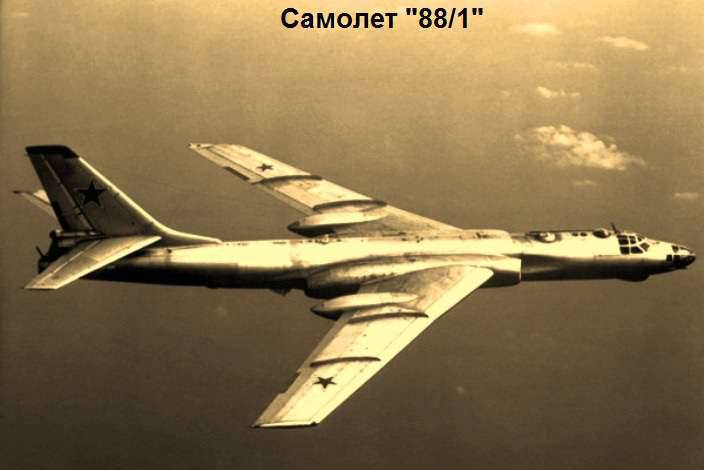
The reason for overweight during the design was the reinsurance of strength engineers, designers. Indeed, in the event of the loss of an experienced car, the Ilyushins could have been able to get so far ahead that the correction of the error and further work on the aircraft already lost its meaning. Everyone tried to hedge: in the course of the calculations, an ordinary designer sketched “just in case” the order of 5%, his manager, driven by the same motives, a little more, etc. As a result, the take-off weight increased by almost 10 tons. In this case, of course, it is worth considering the influence of the initial installation - to design an airship for two engine variants, 2-4 TRD AL-5 or 2-X AM-3, which also led to the introduction of excess mass in the project. As you can see, the reserves to deal with the weight of the aircraft was enough.
These reserves were effectively implemented during the construction of the second prototype flight, the “88 / 2 aircraft”, which was manufactured according to the same government and air force assignments as the first one, but without exact dates. Initially, the car was supposed to be just the “understudy” of the first flight copy, but by August 1951, when the 88 / 1 was almost ready, and it became clear to all that the plane was overweight, the designers were given the task of maximally reducing the weight of the empty machine. Now work has begun on the creation of many structural elements of an almost new aircraft. As a result of the work carried out by designers and technologists, the mass of the empty machine was reduced by 12,5% to 36490 kg - for aviation, where the struggle is over every kilogram, this is a very impressive result.
Design work on the “Doubler” began in August 1951 of the year, in parallel, the manufacture of the aircraft began at the pilot plant No. XXUMX. And the design of the new lightweight aircraft was completed in November 156 of the year. The revised working drawings of the lightened aircraft were fully prepared by the OKB for December 1952. The second prototype, the 1952 / 88 aircraft, was made at the start of the new 2 of the year. By March, all the necessary development work on the backup aircraft was completed, and 1953 in March 14 sent the car to factory flight tests, which ended in early September. The car, after all the improvements, was presented on September 1953 for control state tests, and on September 16 the plane was accepted by the military.
The control state tests of 10 on April 1954 of the year ended, almost a year after the first take-off of the “understudy”. During state tests, the car made 65 flights, flying in general 154 hours. 33 minutes. "The 88 / 2 aircraft" with good performance passed state tests and 28 in May 1954 was adopted by our Air Force.
Serial production of Tu-16 bomber, as originally planned, was launched in 1953 year. Successively, aircrafts of various modifications produced three serial aircraft plants: Kazan No. XXUMX, Kuibyshev No. XXUMX and Voronezh No. XXUMX. In addition, other serial aircraft factories participated in the production of parts of the airframe elements. Hundreds of specialized plants of the Ministry of Aviation Industry and other ministries, which supplied systems, equipment and various components, for mass production of Tu-22б were included in the production process of this machine, advanced for its time. The serial production of the Tupolev machine continued until the end of the 1. In total for 64 years 1 machines were manufactured, moreover, another 1963 prototype aircraft was built at plant No. 10.
The first mass production of the Tu-16 was mastered by the Kazan Plant No. 22, which produced the Tu-1947 bombers from 4. This aircraft plant became the head of the series Tu-16 for aircraft factories No. XXUMX and No. XXUMX.
The first production car was manufactured in Kazan on October 29 1953 of the year, and by the end of the year it was transferred to the customer of the 2 aircraft. In 1954, the factory already produced 70 machines. In 1955, Kazan gave the country 200 machines, in 1956 - 133, in 1957 - 170 and in 1958 - 75. From 1953-th to 1959-th year, the plant produced the following aircraft variants: Tu-16 bomber, Tu-16А nuclear bomber carrier, Tu-16X launch vehicle, Tu-16 Jolka aircraft carrier. In 1958, Kazan began mass production of the passenger liner Tu-104B. In the next 1959, this plant began to switch to serial production of the Tu-22, and the production of the Tu-16 at aircraft plant No. XXUMX temporarily stopped.
From 1957 to 1959 years, a number of experienced and pre-production missile carriers for the Navy Aviation of the Tu-16K-10 type were produced at the Kazan plant, which were obtained by re-equipment of the serial Tu-16. Starting from 1959, the Tu-16K-10 missile-carrier series was deployed at aircraft plant No. XXUMX, and in 1, due to the conversion of the Kuybyshevsky plant to the production of rocket technology, the missile-carrier series was restored at factory No. 1961. The latest copies of the Tu-22K-16 were manufactured on the eve of 10.
From May 1961, the USSR began to release a new engine modification - RD-ЗМ-500 with an increased resource. An emergency mode of operation of the engine with the 10600 kgf engine was introduced, which was intended in case a failure of one of the aircraft's engines took off. The operating time of the turbofan engines in this mode was limited to two minutes, which allowed to overcome the critical situation, but the RD-ZM-500 then required major repairs. The warranty life of the RD-ZM-500 engines was initially 500 hours, and then it was reduced to 2000 hours.
September 19 issued a Resolution of the Council of Ministers of the USSR, and September 25 1953 - the corresponding order of the Ministry of aviation industry to expand serial production of the "sixteenth", which indicated the beginning of serial production at the aircraft plant number XXUMX in Kuybyshev (now Samara). In July, 1, this plant manufactured the first Tu-1954. In total, 16 aircraft were launched in 1955 in Kuibyshev, 130 in 1956, 131 in 1957, 150 in 1958, 50 in 1959 and in 30. From 1960-th to 42-th plant No.1961 led the mass production of missile-carrying Tu-1962K-1. The latest copies of the "Sixteenth" aircraft plant №16 were handed over in June 10 of the year. In just 1 years, 1959 Tu-5 series of various modifications were released.
As for the cost of the Tu-16, it depended on the performance, and the configuration of the machines differed from the manufacturing plants. Therefore, it is easier to focus on the cost of export machines. In 1967, the Tu-16Р aircraft from among those supplied to Egypt was valued at 800.508 in foreign currency rubles, which was comparable to the cost of the MiG-21 fighter.
In addition to the main production of the Tu-16 aircraft, all of the specified serial plants actively participated in ongoing programs for the modification and modernization of the Tu-16 aircraft, re-equipping production machines into new versions for various purposes, or producing component parts and assemblies for reworking in operating and repair parts Air Force It is worth noting that, in addition to 11 produced serial versions, there were about 50 modifications of the "sixteenth", which were obtained by modifications in the system.
In winter, 1954, the first copies of the Tu-16 began to arrive in the long-range aviation, and naval aviation. At that time, in its main characteristics, the aircraft corresponded to the level of the world's best bombers. He had modern equipment, and besides, he stood out among the machines of the same type with exceptionally powerful and rationally placed defensive armament. Similar American and British machines had, at best, a single feed installation. The “sixteenth” had defensive armament with three cannon installations: the upper DT-B7, the lower DT-H7 and the stern DK-7. Each of the installations was armed with a pair of TKB-495A guns (AM-23) developed in TsKB-14. The authorship of the guns belonged to the gunsmiths of the Tula TsKB-14 N.M. Afanasyev and N.F. Makarov (the famous creator of the pistol PM). Replacing the guns was dictated by their significant advantages over those previously provided for by the HP-23; the rate of fire of the new guns and the second salvo were one and a half times higher. The turnaround speed of the units was at least 45 degrees per second, which allowed firing at high-speed, highly manoeuvrable targets. The guns had a shortened barrel to ensure the required mobility in conditions of high-speed air flow. At the same time, the gun, in a fixed bow installation PU-88, had an elongated one and a half meter trunk. The upper set of ammunition was 500 cartridges, the bottom one was 700, and the stern was 1000 cartridges. For shooting used a radar sight "Argon".
A public presentation of the Tu-16 took place on 1 on May 1954 of the year, during the aviation component of the parade over Red Square. The 9 bombers of the 203 heavy bombing regiment passed over Moscow in dense formation. The show was also watched by military attaches from many countries of the world who were present at the parade. It is interesting to give an estimate of the “sixteenth” by foreign experts: the bomb load was called equal to 9000 kg and was estimated quite accurately, as was the take-off weight of the bomber, from 70000 to 80000 kg. The range was determined to be equal to the entire 4800 km, and the engines, in their opinion, developed a maximum thrust of 6800 kg each. Even so, the Soviet TRD was called the most powerful in the world at that time. Western experts could not even imagine how far we were able to step forward on the planet in creating powerful TRDs, underestimating the correct figures, almost one and a half times. Even more entertaining was the statement by Western aviation experts that "a certain number of aircraft of this type are used as air defense fighters to protect the most important objects."
The operational implementation of the "sixteenth" in the series went along with the fine-tuning of its design, ensuring reliable operation of the machine and bringing its resource indicators to the required values. All this was the result of constant hard work of the OKB staff, who headed the chief designer of the Tu-16 DS Markov.
Half a century of successful operation of a huge family of Tu-16 in a variety of difficult conditions has become an excellent test of the quality of various domestic aviation materials; from lightweight high-strength alloys to plastics and electrical insulating materials used in the electrical system. "Tu-sixteenth" became for the Soviet aviation science a pioneer in the class of heavy jets. In the course of its testing and further operation, a number of theoretical problems were uncovered, which were promptly and successfully resolved, opening the way for the further development of domestic aviation. The successful mass operation of the Tu-16 made it possible to firmly enter the Soviet aircraft construction of the swept wing scheme for heavy-duty machines of various classes and provided invaluable practical information for the creation of subsequent heavy machines that were designed and built in the OKB design bureau. Tupolev.
For our Air Force, the Tu-16 became the first machine of the Long-Range Aviation, where domestic combatant pilots were able to reach subsonic speeds. The pilots of long-range aviation and naval aviation, in the fifties, could honestly claim to serve on one of the most advanced combat aircraft in the world. In the Soviet Air Force, the Tu-16 became the first, truly mass, long-distance carrier of atomic weapons, and in addition, the first long-range high-speed rocket-carrying aircraft. On these machines, for the first time in large numbers, Soviet pilots mastered and used the in-flight refueling system. Operation of the "sixteenth" in the air force units provided an opportunity to train highly qualified personnel of the flight and ground personnel, ensuring a smooth transition to high-speed heavy combat vehicles of the next generation, such as the Tu-22, Tu-22M and Tu-160. Also, it was the Tu-16 crews who easily transferred to the first passenger jet Tu-104, having largely solved the problems with personnel in the domestic civil air fleet, during the introduction of the new jet technology.
The Tu-16 actively flew until the end of the eighties, standing up in one row in terms of operating time with such famous cars as the overseas B-52 and our Tu-95, but unlike other long-livers, the “sixteenths” were treated with a minimum of large design modifications.
In the course of production, more than 50 versions of various types of Tu-16 were mastered. Below are only the main part of the modifications.
Tu-1А (1954 year) The carrier of nuclear weapons. The aircraft bomb bay was equipped with a heating system. Produced by 453 aircraft.
The Tu-16X (1954) missile carrier armed with two anti-ship missiles KS-1, which were developed in the OKB-155 A.I. Mikoyan. KS-1 had a starting weight in 2766 kg. The launch range was 80 km. First of all, the system was designed to fight the enemy aircraft carriers.
Tu-16 (1955) A refueling aircraft for aerial refueling of Tu-16 bombers of other modifications. In total, more than 100 serial machines were converted.
Tu-16PS (1955) Jammer.
Tu-16P (1956) Photo Intelligence. The aircraft was equipped with seven aerial cameras, an active jamming station and equipment for conducting electronic reconnaissance of the CPC-3, located in the underwing suspension containers.
Tu-16B (1957) It was an experienced aircraft, which was tested TRD RD-16 with a maximum thrust 11 000 kgf. The characteristics of the aircraft has increased markedly. The project envisaged the achievement of a flight range in 7200 km and speeds up to 1050 km / h. Serially the car was not made.
Tu-16P (1957) Jammer. In the bomb bay of the machine, four stations were mounted for active jamming.
Tu-16 "Yolka" (1957) The director of passive interference, the plane housed machines for cutting and emitting dipole reflectors.
Tu-16T (1957) Torpedo aircraft. The car had the ability to carry torpedoes, depth bombs, aircraft mines. In the late sixties, almost all Tu-16T were converted into anti-submarine Tu-16PL.
Tu-16K-10 (1961) A missile carrier armed with one anti-ship missile K-10С capable of carrying a nuclear warhead.
Tu-16K-16 (1962 g.) A missile carrier with two KSR-2 anti-ship missiles.
(On the whole, the family of rocket-carrying aircraft and specialized vehicles created on the basis of the Tu-16 deserves a separate large article, which will be prepared some time later.)
The appearance of a bomber in the Soviet Union, a new long-range bomber, very soon aroused interest among foreign customers. Almost all of them belonged to countries that were undergoing revolutionary changes, which were so rich in the political life of the fifties. It was also common that all these countries urgently needed to replenish and update their arsenals - both for the realization of their own ambitions and the existence of conflicts with neighboring states, and for “protecting the revolution” from the “bearers of democracy”. Therefore, an uncommon bomber in its characteristics and combat capabilities turned out to be very attractive for a number of states focused on our country. And it was precisely abroad that the Tu-16 had a chance to “smell gunpowder”, but this is in the next part.
To be continued ...
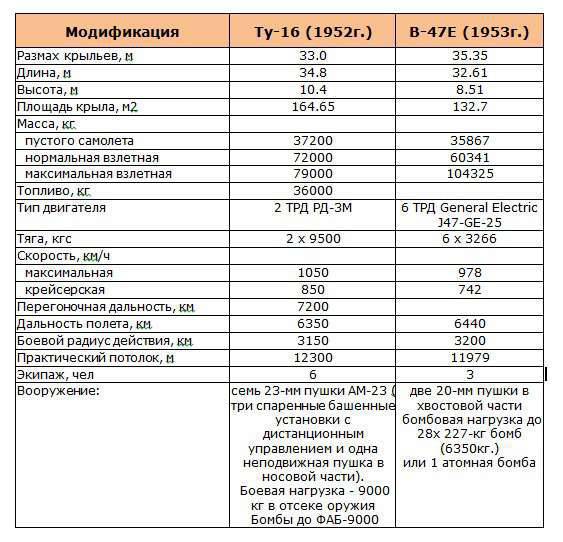
Sources:
Rigmant V. How was created Tu-16. About the predecessors of the great aircraft // Wings of the Motherland. 2002. No.5. C. 18-25.
Markovskiy V., Prikhodchenko I. The missile carrier Tu-16. The triumph of the Soviet aviation industry. M .: Yauza, 2015. C.174-191.
Rigmant V. Tu-16. Birth of a long-liver // Aviation and cosmonautics. 2002. No.5. C. 20-28.
Gordon E., Kudryavtsev V., Rigmant V. Legendary Tu-16 // Aviation and Time. 2001. No.1. C.4-24.
Gordon E., Kudryavtsev V., Rigmant V. Legendary Tu-16 // Aviation and Time. 2001. No.2. C.4-22.
Yakubovich N., Artemyev A. Tupolev Tu-16. Long-range bomber and missile carrier. M .: AST, 2001. C.12-34, 48-97, 111-122.
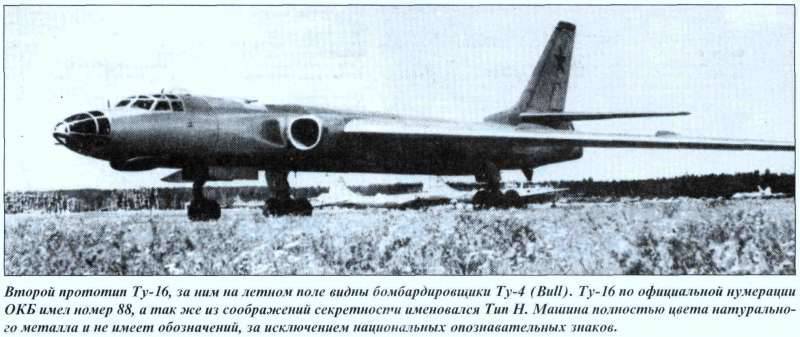
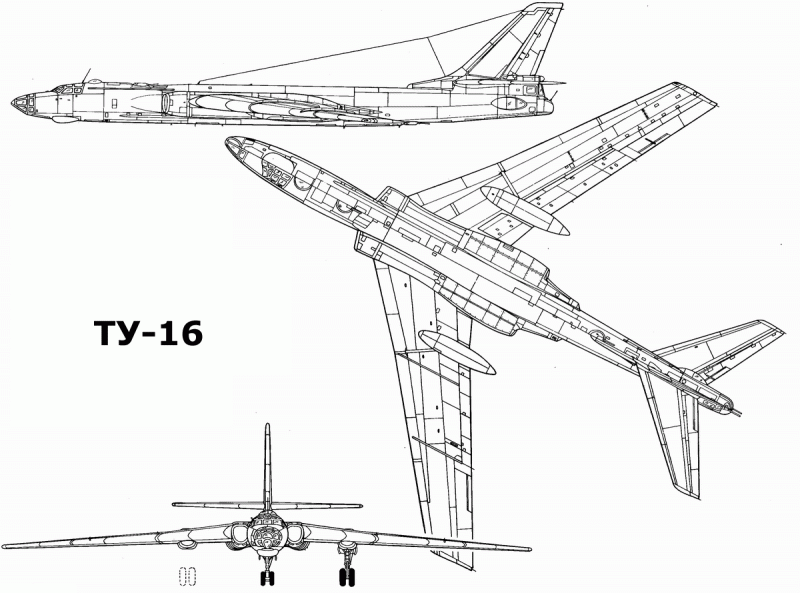
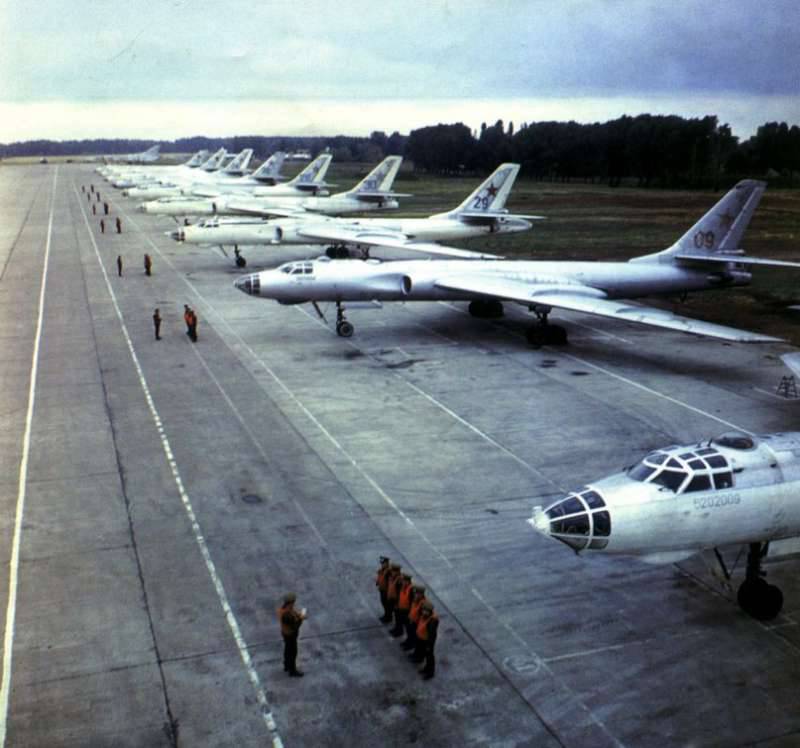
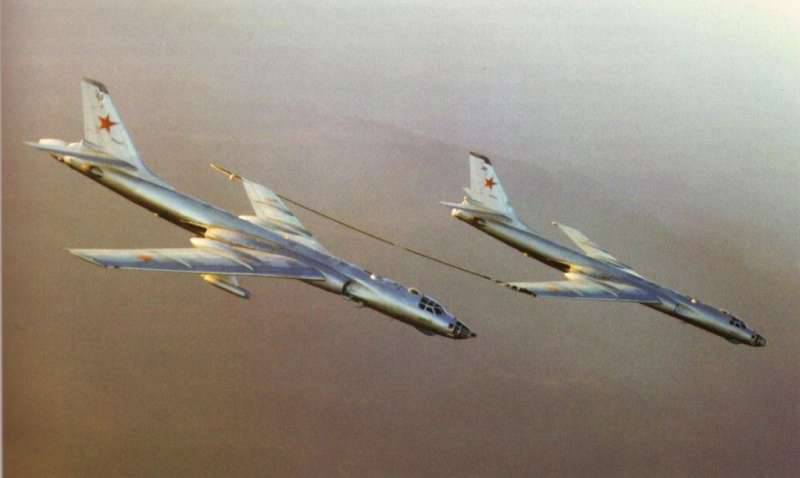
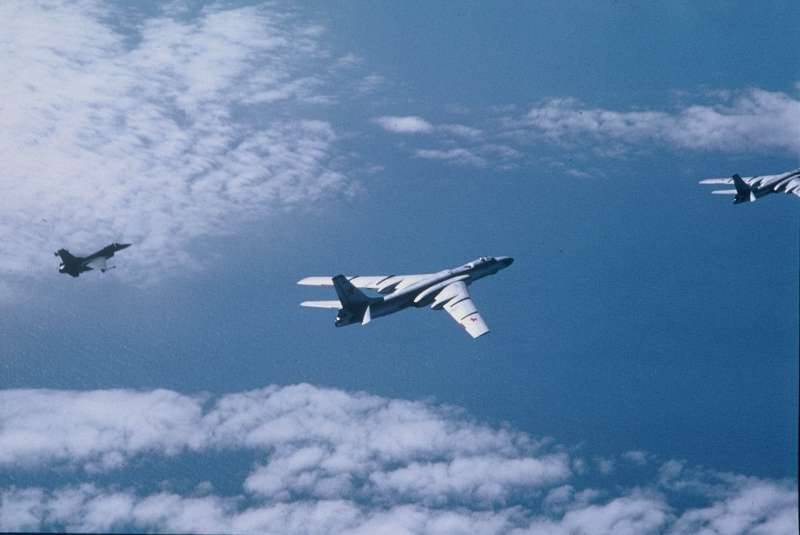
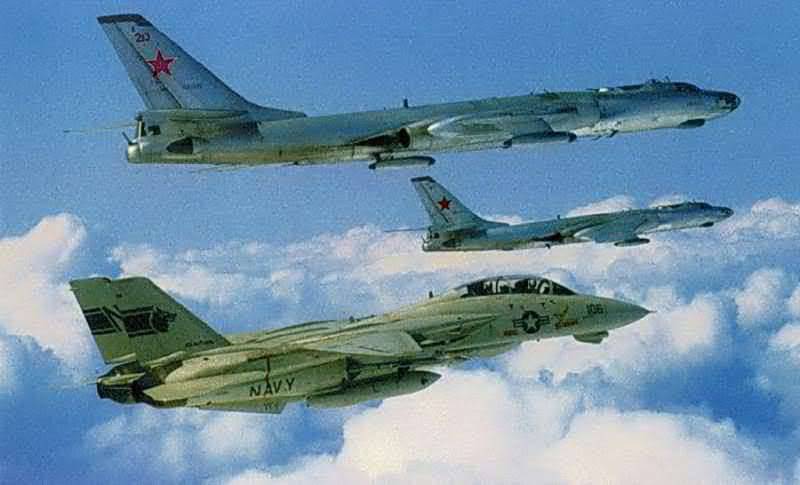
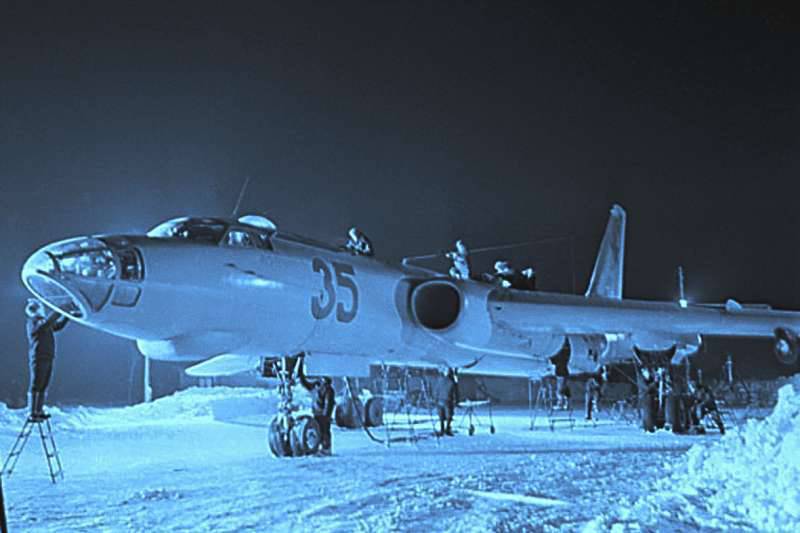
Information